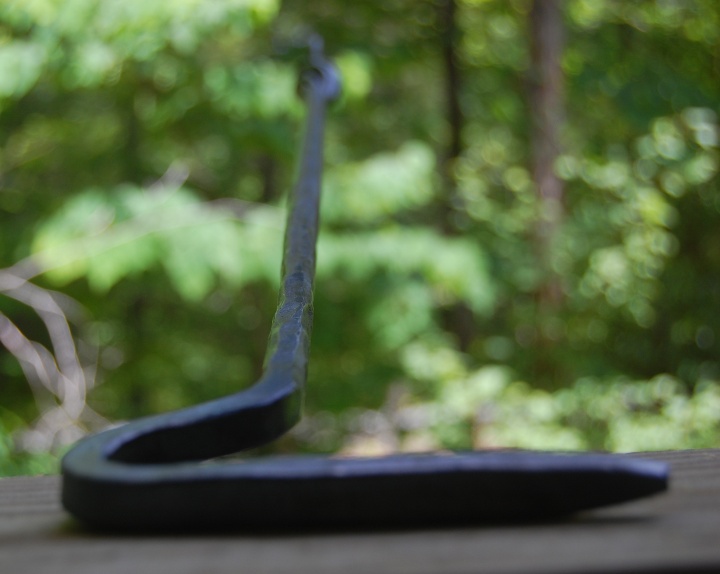My custom blacksmith power hammer with automotive brake rotor clutch is 6'1" tall and weighs over 1000 pounds. It has about 100 individual parts, most of which required multiple metal working operations. This is the design I wanted, fabricated with the materials I had available or I specified to use. My wife named it "Whacker".
After operating this blacksmith power hammer for over a month, I would not materially change anything about this design. It hits very hard. It smoothly slows down for lighter impacts when finish forging. Even a 35 pound hammer barely hitting can easily make a pretty good mark in hot steel.
The 660 pound anvil is a good size considering my stipulation of not damaging the concrete pad. The machine is sitting on a piece of horse stall mat. The concrete under the horse mat has a slope of 1/4" in a foot. With the post braces installed the power hammer seems to be staying in place.
The 4"x4"x3/8" frame post is very sturdy. Before the anvil braces were installed the machine was creeping across the rubber horse mat. The hammer is really solid now.
The 6" radius of top surface of the 1.5"x1.5"x3" dies seem to be working fine so far. The finish on drawn out material looks obviously hammered but not too rough for my taste. The shaft of the fireplace poker photographed above was hammered on the Disk Power Hammer only.
The UHMW-PE hammer track bushings are extremely slick, inexpensive, available and easy to replace. This looks like an ideal material to use. They are staying in place by only the clamping force of the brackets.
The Dupont linkage is amazing technology. I see why other power hammer users like it so much. The at rest die spacing is 1.3 inches and is working nicely. I have not yet used tooling in the hammer.
The 2" diameter 4" long springs are designed to be compressed a maximum of 50% of their length or 2" each. The springs are currently being compressed a about 1" each. So, there is a good bit of excess spring capacity to allow an increase of the speed of the machine. With the 1.75" OD drive pulley we are getting about 3 impacts per second. Whenever I feel more comfortable with a faster speed, I will try a little larger drive pulley.
The automotive brake rotor clutch system is a very nice system. The transition between clutch slippage and engagement is really smooth. It is very easy to regulate the speed of the impacts. It's much smoother than the clutch in my pickup truck.
The Baldor 1.5 HP motor has plenty of power. I'm glad I found the lower speed, 1140 rpm three phase motor that allows the simple drive system.
Even though the brake rotors are heavy, there is not enough flywheel effect for the power hammer to continue running after the clutch is released. The crankshaft rotation stops within one cycle anytime the foot petal is released so a brake is not necessary.
I am very please with my new mechanical Disk Power Hammer. Whenever I feel comfortable enough to handle more than 3 impacts per second, I may increase the size of the motor drive pulley.
Fred Connell - Student Blacksmith
|

